The AI-based Research Services Market is expected to record a valuation of USD 7,972.1 million in 2025 and USD 35,420.4 million in 2035, with an increase of USD 27,448.3 million, which equals a growth of 344% over the decade. The overall expansion represents a CAGR of 16.1% and a 4.4X increase in market size.
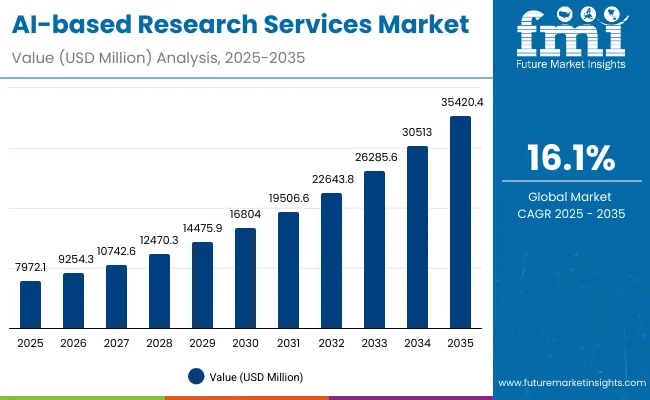
AI-based Research Services Market Key Takeaway
| Metric | Value |
|---|---|
| Estimated Value in 2025E | USD 7,972.1 million |
| Forecast Value in 2035F | USD 35,420.4 million |
| Forecast CAGR (2025 to 2035) | 16.1% |
During the first five-year period from 2025 to 2030, the market increases from USD 7,972.1 million to USD 16,804.0 million, adding USD 8,831.9 million, which accounts for 32% of the total decade growth. This phase records steady adoption across consumer packaged goods (CPG) & retail, financial services, and technology industries, driven by the need for faster consumer insights and predictive analytics. AI-accelerated survey analytics dominates this period with 38.3% share, as enterprises increasingly automate survey feedback and real-time opinion tracking.
The second half from 2030 to 2035 contributes USD 18,616.4 million, equal to 68% of total growth, as the market jumps from USD 16,804.0 million to USD 35,420.4 million. This acceleration is powered by the widespread deployment of synthetic respondents, predictive AI models, and sentiment intelligence platforms across enterprises. Managed services hold a leading share of 61.7%, while China emerges as the fastest-growing country with a 14.3% CAGR, driven by large-scale use of AI-based text and social data analytics. By 2035, global players such as Qualtrics, Kantar, Ipsos, and Dynata expand their AI-driven SaaS and hybrid research platforms, fueling recurring subscription revenues.
From 2020 to 2024, the AI Market Research Services industry grew steadily as enterprises began experimenting with automation, predictive analytics, and social listening tools. During this phase, the competitive landscape was dominated by traditional research firms controlling the majority of revenue, with leaders such as Kantar, Ipsos, and NIQ leveraging established survey-based methodologies. Competitive differentiation largely relied on panel size, reach, and cost efficiency, while AI capabilities were often positioned as add-ons rather than core offerings. Pure-play AI-led service providers had limited traction, contributing less than 15% of the total market value.
Demand for AI-driven market research accelerates to USD 7,972.1 million in 2025, and the revenue mix shifts as platform-led models and managed services account for over 60% of growth. Traditional leaders now face rising competition from digital-first firms like Qualtrics, Zappi, and Quantilope, which offer self-serve SaaS platforms, virtual panel simulations, and subscription-based insights. Major incumbents are pivoting to hybrid delivery models, integrating analytics dashboards, synthetic respondents, and real-time sentiment engines to retain relevance. Emerging entrants specializing in cloud interoperability, predictive modeling, and multimodal data analytics (text, image, voice, and clickstream) are gaining share. The competitive edge is moving away from survey scale alone to ecosystem strength, speed, scalability, and recurring SaaS revenues.
The adoption of AI-driven respondent modeling is reducing dependency on costly, time-consuming human panels. Virtual simulations allow enterprises to test concepts, ads, and messaging instantly at scale, enabling faster time-to-insight. This structural shift is driving efficiency gains and boosting demand across consumer-focused industries.
Companies are increasingly leveraging AI to analyze unstructured datasets such as reviews, call transcripts, and shopper behavior telemetry. The ability to unify these data streams into predictive insights gives businesses a competitive edge, fueling adoption of AI-powered market research platforms in sectors like retail, technology, and financial services.
The AI-based Research Services Market is segmented by service type, delivery model, data modality, end-use industry, pricing model, and region. Key service types include survey analytics, predictive forecasting, sentiment analytics, creative testing, and synthetic respondent simulations. Delivery spans SaaS platforms, managed services, and hybrid models, while data modalities cover text, image/video, behavioral, and voice sources. End-use industries range from CPG & retail, technology, and healthcare to finance, automotive, and media. Pricing models include subscription, project-based, and API usage. Regionally, North America and Europe remain strongholds, with Asia-Pacific, especially China and India, showing the fastest growth.
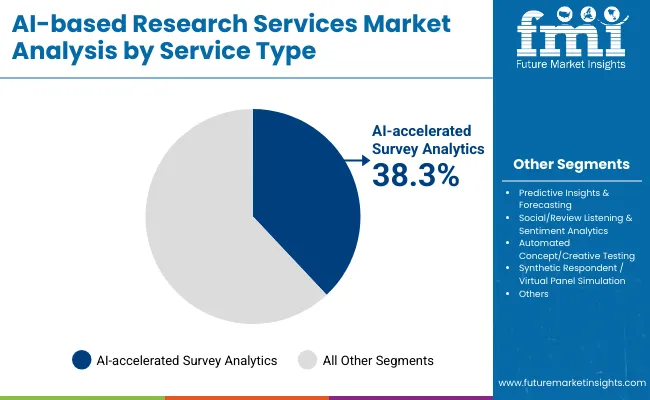
| Service Type | Value Share% 2025 |
|---|---|
| AI-accelerated survey analytics | 38.3% |
| Others | 61.7% |
The AI-accelerated survey analytics segment is projected to contribute 38.3% of the AI-based Research Services revenue in 2025, maintaining its lead as the dominant service category. Growth is driven by enterprises adopting automated tools to streamline survey design, capture real-time feedback, and generate predictive insights at scale. Organizations are prioritizing these solutions for their ability to reduce costs, minimize human bias, and accelerate decision-making across industries.
The segment’s expansion is also supported by the integration of natural language processing (NLP) and generative AI, which enhance analysis depth and enable multilingual, multi-market survey deployment. As hybrid research models and cloud-based platforms become more prevalent, AI-accelerated survey analytics is expected to remain the backbone of AI-driven market research, powering both consumer insights and enterprise intelligence functions.
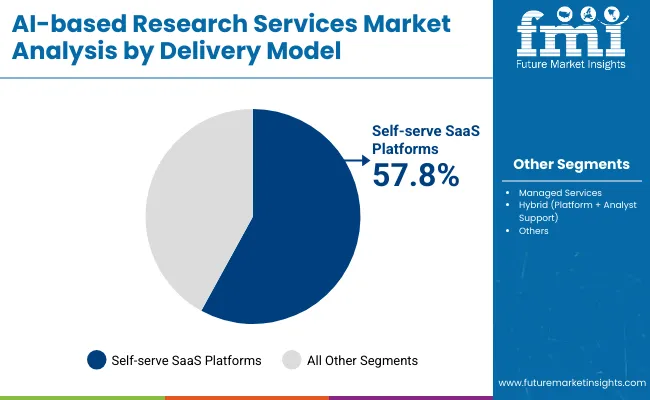
| Delivery Model | Value Share% 2025 |
|---|---|
| Self-serve SaaS platforms | 57.8% |
| Others | 42.2% |
The Self-serve SaaS platforms segment is forecasted to hold 57.8% of the market share in 2025, driven by its ease of deployment, scalability, and cost efficiency. These platforms allow businesses to quickly adopt AI solutions without requiring heavy infrastructure investments, making them particularly attractive for SMEs and enterprises aiming for rapid AI integration. Their user-friendly interfaces, subscription-based pricing, and ability to deliver real-time insights have facilitated widespread adoption across industries such as retail, healthcare, BFSI, and manufacturing. The segment’s growth is further bolstered by advancements in cloud computing and low-code/no-code tools that simplify AI implementation.
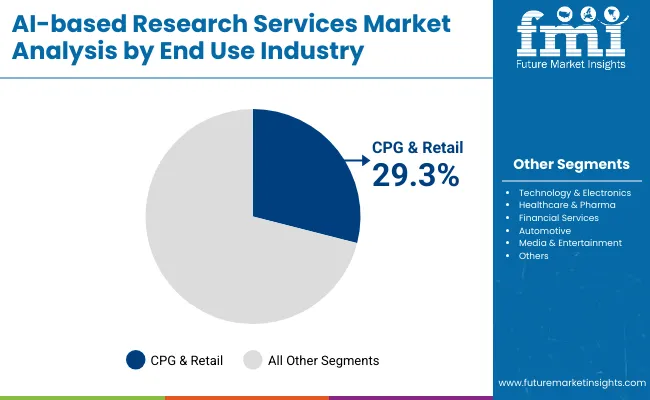
| End Use Industry | Value Share% 2025 |
|---|---|
| CPG & Retail | 29.3% |
| Others | 70.7% |
The CPG & Retail segment is projected to account for 29.3% of the AI-based Research Services revenue in 2025, establishing it as the leading end-use industry. This segment is driving adoption due to its constant need for real-time consumer insights, demand forecasting, and competitive benchmarking. Retailers and consumer goods companies are increasingly relying on AI to analyze shopper behavior, track sentiment across digital channels, and optimize product launches.
Its suitability for capturing large-scale consumer feedback and integrating diverse data sources such as reviews, social media, and clickstream analytics has made it a natural fit for this industry. Advancements in predictive modeling and virtual panel simulations further enhance decision-making speed, enabling brands to respond quickly to shifting consumer preferences. Given its scale and innovation intensity, CPG & Retail is expected to maintain its leading role in the AI-based Research Services Market throughout the forecast period.
Rise of Synthetic Respondents and Virtual Panels
One of the strongest growth drivers is the emergence of synthetic respondents and AI-powered virtual panels. Traditional research methods rely on time-intensive human panels that are costly, prone to fatigue, and geographically limited. By contrast, synthetic respondents simulate human-like behavior and decision-making, enabling companies to test concepts, advertisements, and product ideas instantly and at scale. This innovation reduces dependence on panel recruitment and accelerates feedback cycles from months to hours. As consumer-facing industries such as CPG, media, and retail increasingly prioritize speed-to-insight, the adoption of virtual panels is expected to expand sharply, driving the structural shift from conventional market research to AI-driven methodologies.
Multimodal Data Integration Enhancing Predictive Insights
The ability to unify and analyze diverse data streams text from surveys and reviews, image/video from creative tests, behavioral clickstream data, and voice from call transcriptsis a significant growth catalyst. Unlike traditional methods that focus heavily on structured survey data, AI enables cross-modal insights by detecting correlations between sentiment, behavior, and purchasing intent. For example, retailers can combine shopper telemetry with social sentiment to forecast demand more accurately, while financial services firms can integrate voice analytics with transaction data to identify emerging risks. This holistic, predictive capability is reshaping how organizations interpret markets, making AI-powered research indispensable for strategy and innovation.
Data Privacy and Ethical Constraints in AI-driven Research
A major restraint in the AI-based Research Services industry is the challenge of data privacy and ethical governance. AI platforms often process sensitive consumer data, including behavioral telemetry, voice transcripts, and sentiment extracted from social platforms. Ensuring compliance with global frameworks such as GDPR, CCPA, and emerging AI regulations adds complexity and cost to deployment. Additionally, concerns about algorithmic bias in synthetic respondents and sentiment models can undermine trust if outputs appear skewed. Enterprises adopting these solutions must balance innovation with ethical safeguards, which slows adoption among highly regulated industries such as healthcare and finance. This restraint could limit rapid scaling unless vendors proactively address transparency and compliance requirements.
Shift Toward Hybrid Delivery Models Combining SaaS Platforms with Analyst Expertise
A key trend shaping the market is the transition from purely managed research services to hybrid delivery models, where AI platforms handle data processing and visualization, while human analysts provide strategic interpretation. Enterprises increasingly seek a balance between automation efficiency and expert contextualization, particularly for high-stakes decisions like product launches or M&A analysis. Hybrid models allow clients to self-serve for routine projects while relying on expert validation for complex studies, ensuring credibility and depth. This trend is also tied to monetization shifts, as providers blend subscription-based SaaS revenue with premium analyst consulting fees, creating sustainable, recurring income streams while maintaining competitive differentiation.
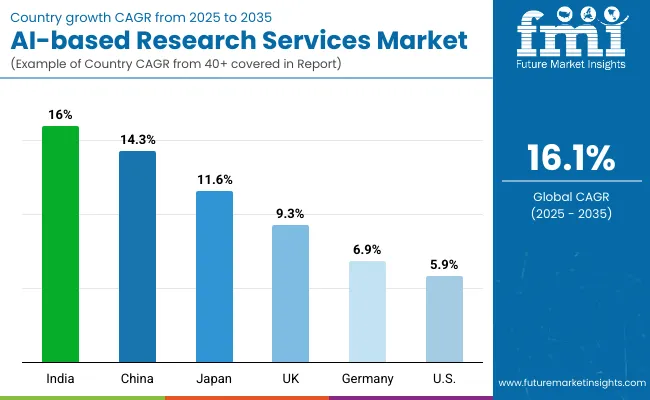
| Countries | Estimated CAGR (2025 to 2035) |
|---|---|
| China | 14.3% |
| USA | 5.9% |
| India | 16.0% |
| UK | 9.3% |
| Germany | 6.9% |
| Japan | 11.6% |
The global AI-based Research Services sector shows clear regional disparities, strongly shaped by digital adoption, enterprise cloud migration, and regulatory frameworks. Asia-Pacific emerges as the fastest-growing region, anchored by China at 14.3% CAGR and India at 16.0% CAGR. Growth here is fueled by heavy investment in AI-enabled consumer insights platforms, government-backed digitalization programs, and expanding e-commerce ecosystems. India’s trajectory reflects rapid enterprise SaaS adoption and increasing outsourcing demand for AI-driven market analytics.
Europe maintains strong momentum, led by the UK at 9.3% and Germany at 6.9%, supported by strict data privacy regulations, corporate ESG compliance reporting, and adoption of AI-driven consumer behavior tracking. Vendors here are leveraging AI to align with GDPR standards while enabling advanced sentiment and predictive analytics.
North America shows steady but mature growth, with the USA at 5.9% CAGR, where AI-based Research Services are deeply integrated into enterprises but shifting toward specialized use cases like hyper-personalized marketing and real-time consumer journey mapping. Japan, at 11.6% CAGR, demonstrates strong adoption of AI-driven retail and CPG research platforms, supported by its innovation focus in customer engagement and digital experience optimization.
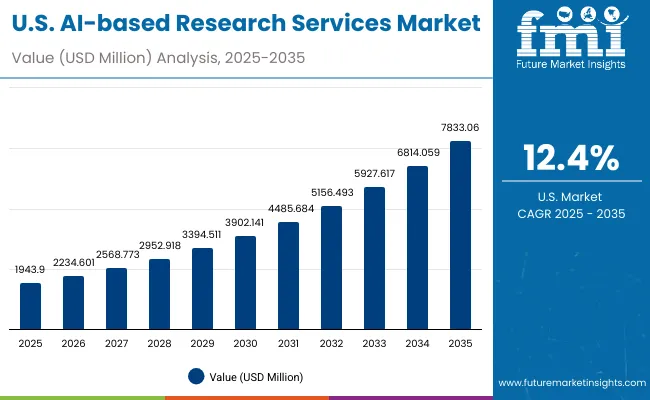
| Year | USA AI-based Research Services |
|---|---|
| 2025 | 1943.90 |
| 2026 | 2234.60 |
| 2027 | 2568.77 |
| 2028 | 2952.91 |
| 2029 | 3394.51 |
| 2030 | 3902.14 |
| 2031 | 4485.68 |
| 2032 | 5156.49 |
| 2033 | 5927.61 |
| 2034 | 6814.05 |
| 2035 | 7833.06 |
The USA AI-based Research Services sector is projected to grow from USD 1,943.9 million in 2025 to USD 7,833.1 million by 2035, reflecting a CAGR of 12.4%. Growth is driven by rising adoption of AI-accelerated consumer insights, predictive analytics, and real-time sentiment tracking across industries.
Adoption is particularly strong in retail, CPG, and financial services, leveraging AI for hyper-personalized campaigns and behavioral modeling. Healthcare and pharma are integrating AI-driven research for patient-centric strategies and drug commercialization, while entertainment and education increasingly deploy AI for adaptive content and audience analytics.
The market is also shifting toward SaaS-based AI platforms, enabling faster, scalable insights delivery. Collaborations between research providers and cloud AI vendors are strengthening competitive positioning.
Key Drivers in the USA
The AI-based Research Services sector in the United Kingdom is projected to grow at a CAGR of 9.3%, driven by adoption across consumer-centric industries and public initiatives. Retail and CPG firms are leveraging AI-driven insights for real-time demand sensing, predictive merchandising, and dynamic pricing models. Financial institutions are increasingly using AI to track market sentiment, fraud indicators, and evolving consumer behavior. Government-backed innovation hubs and university-led AI research programs are boosting adoption, particularly among SMEs. Meanwhile, media and entertainment companies are integrating AI for audience engagement analytics and targeted content personalization.
India is set to register one of the fastest growth trajectories in the AI-based Research Services sector, with a projected CAGR of 16.0% through 2035. The expansion is fueled by rising adoption among MSMEs in tier-2 and tier-3 cities, supported by lower entry costs and cloud-based platforms. Consumer goods firms are using AI-driven analytics for distribution optimization and rural demand forecasting, while telecom players are leveraging AI to track churn and digital service uptake. Academic institutions and skilling centers are embedding AI tools into research curricula, preparing talent pipelines for AI-enabled industries. Government-backed Digital India initiatives and data localization policies are further accelerating adoption across public and private sectors.
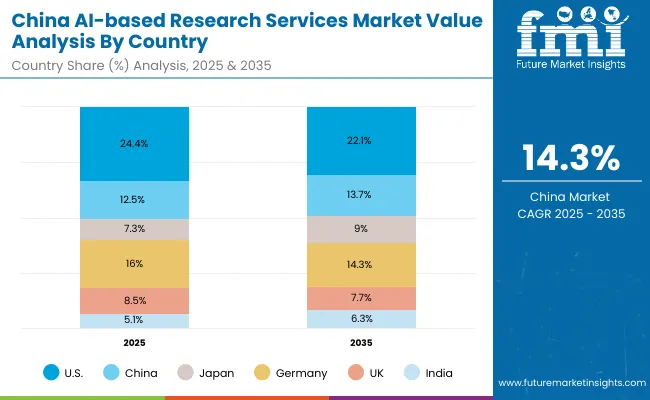
The AI-based Research Services sector in China is expected to grow at a CAGR of 14.3%, the highest among leading economies. Growth is driven by smart city programs, large-scale digital transformation projects, and aggressive competition among local AI providers. Consumer electronics and automotive firms are deploying AI-driven research to accelerate product development and customer insights. Municipal governments are integrating AI-based analytics into urban planning, mobility solutions, and public service optimization. The rise of cost-effective AI platforms from domestic companies is expanding access across education, retail, and e-commerce ecosystems. With strong state support and cross-industry digitization, China is cementing itself as a global AI research hub.
| Countries | 2025 Share (%) |
|---|---|
| USA | 24.4% |
| China | 12.5% |
| Japan | 7.3% |
| Germany | 16.0% |
| UK | 8.5% |
| India | 5.1% |
| Countries | 2035 Share (%) |
|---|---|
| USA | 22.1% |
| China | 13.7% |
| Japan | 9.0% |
| Germany | 14.3% |
| UK | 7.7% |
| India | 6.3% |
Germany holds a 16.0% global share in 2025, projected to decline slightly to 14.3% by 2035, though the market will still expand in absolute terms at a CAGR of 6.9%. Growth is underpinned by precision engineering strengths, Industry 4.0 adoption, and compliance-driven innovation. German enterprises are integrating AI-powered research platforms with industrial automation to enable real-time quality assurance and efficiency gains.
Manufacturing firms are adopting AI-driven insights for CNC workflow optimization, predictive maintenance, and supply chain forecasting, while healthcare labs are shifting toward digital modeling in dental and orthopedic care, reducing errors and turnaround time. Strict EU compliance standards and a strong emphasis on sustainable prototyping and production are further accelerating adoption across traditional and advanced manufacturing.
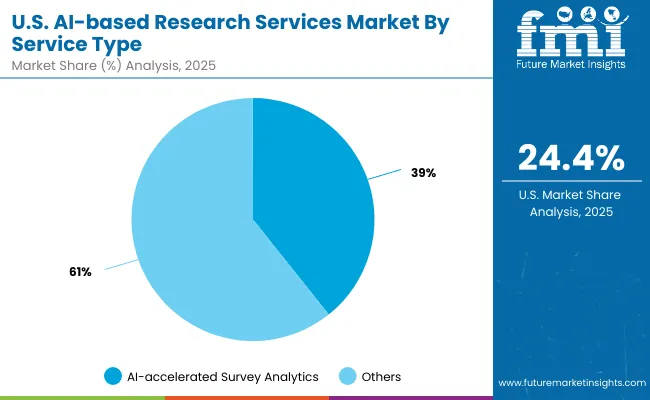
| USA By Service Type | Value Share% 2025 |
|---|---|
| AI-accelerated survey analytics | 39.3% |
| Others | 60.7% |
The USA accounts for 24.4% of the global AI-based Research Services share in 2025, projected to ease slightly to 22.1% by 2035, though the market will continue expanding in absolute terms. Growth is driven by the country’s leadership in AI-accelerated analytics, cloud infrastructure, and enterprise digital transformation. By 2025, AI-accelerated survey analytics alone represent 39.3% of the USA market, reflecting strong demand for faster, more accurate consumer insights.
Enterprises are increasingly embedding AI into survey design, sentiment analysis, and behavioral prediction to enhance decision-making across retail, finance, and healthcare. Advanced cloud ecosystems, combined with large-scale structured and unstructured datasets, further strengthen the USA position as a hub for innovation. Regulatory flexibility and the presence of major AI vendors also foster rapid commercialization of AI-driven market research platforms.
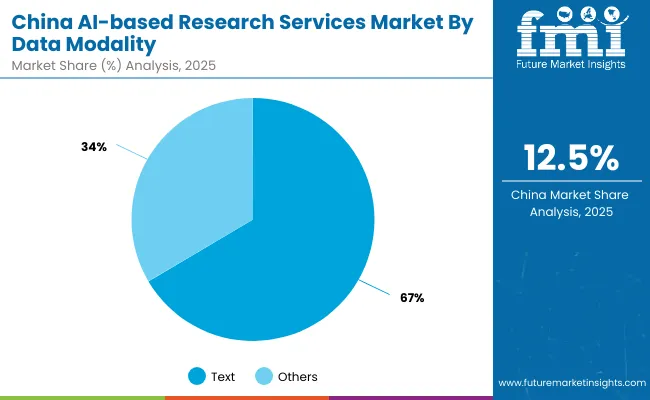
| China By Data Modality | Value Share% 2025 |
|---|---|
| Text | 66.5% |
| Others | 33.5% |
China holds 12.5% of the global AI-based Research Services share in 2025, projected to rise to 13.7% by 2035, supported by its massive digital ecosystem, government-backed AI programs, and strong local tech players. By modality, text-based data dominates with 66.5% share in 2025, reflecting the overwhelming scale of e-commerce, social media, and mobile-first interactions that generate vast volumes of text-rich consumer data.
Chinese enterprises are increasingly leveraging AI-driven NLP platforms to analyze consumer sentiment, optimize digital campaigns, and predict buying behavior across retail and financial services. The availability of large, local-language datasets provides a competitive advantage, enabling algorithms that capture cultural nuance with higher accuracy than global peers. Beyond text, demand for voice and video analytics is rising in smart city initiatives, compliance monitoring, and retail operations.
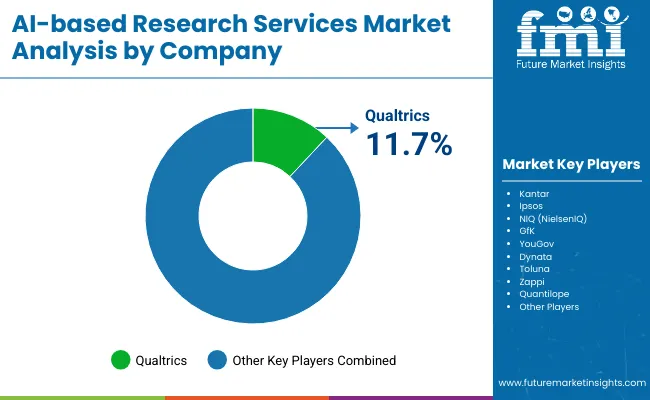
In 2025, Qualtrics holds 11.7% of the global AI-based Research Services share, while the remaining 88.3% is split among a wide range of competitors, indicating a moderately fragmented landscape. The market is shaped by a mix of global technology leaders, mid-sized innovators, and niche-focused providers, each targeting distinct service models and client segments.
Global leaders such as Qualtrics, NielsenIQ, and Ipsos are driving adoption through AI-accelerated survey analytics, predictive modeling, and cloud-based platforms that integrate seamlessly with enterprise software ecosystems. Their strategies increasingly focus on end-to-end research automation, real-time consumer insight generation, and integration with business intelligence platforms.
Mid-sized innovators including SurveyMonkey (Momentive), Dynata, and Lucid are differentiating by offering cost-efficient SaaS research tools powered by AI-based text, voice, and image analytics. They emphasize portability, user-friendliness, and integration with marketing and CRM systems, making them especially relevant for SMEs and digital-first enterprises.
Specialist providers such as Remesh, Black Swan Data, and Zappi focus on niche AI applications, including conversational AI for focus groups, predictive trend analysis, and rapid product testing. Their competitive strength lies in customization, agility, and regional adaptability, often outperforming larger firms in targeted use cases.
Competitive differentiation is increasingly shifting away from traditional survey design toward AI-driven ecosystems, where predictive analytics, multimodal insights, and subscription-based service models are key levers of market success.
Key Developments in AI-based Research Services Market
| Item | Value |
|---|---|
| Quantitative Units | USD 7,972.1 Million |
| Service Type | AI-accelerated survey analytics, Predictive insights & forecasting, Social/review listening & sentiment analytics, Automated concept/creative testing, Synthetic respondent / virtual panel simulation |
| Delivery Model | Self-serve SaaS platforms, Managed services, Hybrid (platform + analyst support) |
| Data Modality | Text (surveys, reviews, social), Image/video (creative tests, shelf/UX sims), Behavioral/clickstream & telemetry, Audio/voice (call/chat transcripts) |
| End Use Industry | CPG & Retail, Technology & Electronics, Healthcare & Pharma, Financial Services, Automotive, Media & Entertainment |
| Pricing Model | Subscription, Project-based, Usage-based/API |
| Regions Covered | North America, Europe, Asia-Pacific, Latin America, Middle East & Africa |
| Country Covered | United States, Canada, Germany, France, United Kingdom, China, Japan, India, Brazil, South Africa |
| Key Companies Profiled | Qualtrics, Kantar, Ipsos, NIQ ( NielsenIQ ), GfK, YouGov, Dynata, Toluna, Zappi, Quantilope |
| Additional Attributes | Dollar sales by scanner type and end-use industry, adoption trends in reverse engineering and quality control, rising demand for handheld and portable 3D scanners, sector-specific growth in aerospace, automotive, and healthcare, software and services revenue segmentation, integration with AR/VR and digital twin technologies, regional trends influenced by digitization initiatives, and innovations in laser triangulation, structured light, and photogrammetry methods. |
The global AI-based Research Services Market is estimated to be valued at USD 7,972.1 million in 2025.
The market size for the AI-based Research Services Market is projected to reach USD 35,420.4 million by 2035.
The AI-based Research Services Market is expected to grow at a 16.1% CAGR between 2025 and 2035.
The key service types in AI-based Research Services Market are AI-accelerated survey analytics, Predictive insights & forecasting, Social/review listening & sentiment analytics, Automated concept/creative testing, Synthetic respondent / virtual panel simulation
In terms of service type, AI-accelerated survey analytics is expected to command 39.3% share in the AI-based Research Services Market in 2025.






Our Research Products

The "Full Research Suite" delivers actionable market intel, deep dives on markets or technologies, so clients act faster, cut risk, and unlock growth.

The Leaderboard benchmarks and ranks top vendors, classifying them as Established Leaders, Leading Challengers, or Disruptors & Challengers.

Locates where complements amplify value and substitutes erode it, forecasting net impact by horizon

We deliver granular, decision-grade intel: market sizing, 5-year forecasts, pricing, adoption, usage, revenue, and operational KPIs—plus competitor tracking, regulation, and value chains—across 60 countries broadly.

Spot the shifts before they hit your P&L. We track inflection points, adoption curves, pricing moves, and ecosystem plays to show where demand is heading, why it is changing, and what to do next across high-growth markets and disruptive tech

Real-time reads of user behavior. We track shifting priorities, perceptions of today’s and next-gen services, and provider experience, then pace how fast tech moves from trial to adoption, blending buyer, consumer, and channel inputs with social signals (#WhySwitch, #UX).

Partner with our analyst team to build a custom report designed around your business priorities. From analysing market trends to assessing competitors or crafting bespoke datasets, we tailor insights to your needs.
Supplier Intelligence
Discovery & Profiling
Capacity & Footprint
Performance & Risk
Compliance & Governance
Commercial Readiness
Who Supplies Whom
Scorecards & Shortlists
Playbooks & Docs
Category Intelligence
Definition & Scope
Demand & Use Cases
Cost Drivers
Market Structure
Supply Chain Map
Trade & Policy
Operating Norms
Deliverables
Buyer Intelligence
Account Basics
Spend & Scope
Procurement Model
Vendor Requirements
Terms & Policies
Entry Strategy
Pain Points & Triggers
Outputs
Pricing Analysis
Benchmarks
Trends
Should-Cost
Indexation
Landed Cost
Commercial Terms
Deliverables
Brand Analysis
Positioning & Value Prop
Share & Presence
Customer Evidence
Go-to-Market
Digital & Reputation
Compliance & Trust
KPIs & Gaps
Outputs
Full Research Suite comprises of:
Market outlook & trends analysis
Interviews & case studies
Strategic recommendations
Vendor profiles & capabilities analysis
5-year forecasts
8 regions and 60+ country-level data splits
Market segment data splits
12 months of continuous data updates
DELIVERED AS:
PDF EXCEL ONLINE
Research Publication Support Service Market Size and Share Forecast Outlook 2025 to 2035
Research And Development (R&D) Analytics Market Size and Share Forecast Outlook 2025 to 2035
Research Antibodies Market Size and Share Forecast Outlook 2025 to 2035
M2M Services Market Size and Share Forecast Outlook 2025 to 2035
B2B Services Review Platforms Market Size and Share Forecast Outlook 2025 to 2035
Bot Services Market Size and Share Forecast Outlook 2025 to 2035
Spa Services Market Size and Share Forecast Outlook 2025 to 2035
Microservices Orchestration Market Growth - Trends & Forecast 2025 to 2035
VOIP Services Market Analysis - Trends, Growth & Forecast through 2034
Global AI HR Services Market Size and Share Forecast Outlook 2025 to 2035
Legal Services Market Size and Share Forecast Outlook 2025 to 2035
Oracle Services Market Analysis – Trends & Forecast 2024-2034
Seismic Services Market Size and Share Forecast Outlook 2025 to 2035
AR Tour Services Market Analysis - Size and Share Forecast Outlook 2025 to 2035
Tableau Services Market Size and Share Forecast Outlook 2025 to 2035
Managed Services Market Analysis - Size, Share, and Forecast Outlook 2025 to 2035
Walk-in Services Market Growth – Trends & Forecast 2024-2034
Clinical Research Organization Market Size and Share Forecast Outlook 2025 to 2035
The AI Legal Services Market Analysis - Size and Share Forecast Outlook 2025 to 2035
Podiatry Services Market Analysis - Size, Share, and Forecast Outlook 2025 to 2035

Thank you!
You will receive an email from our Business Development Manager. Please be sure to check your SPAM/JUNK folder too.
Chat With
MaRIA